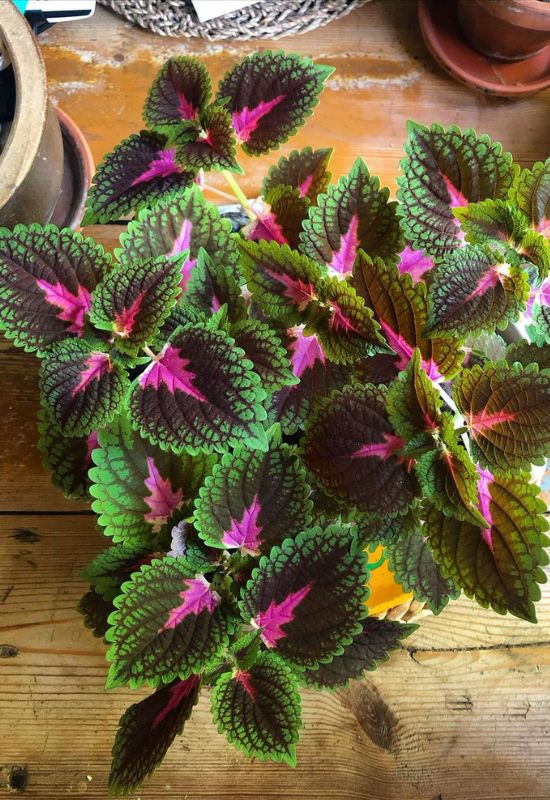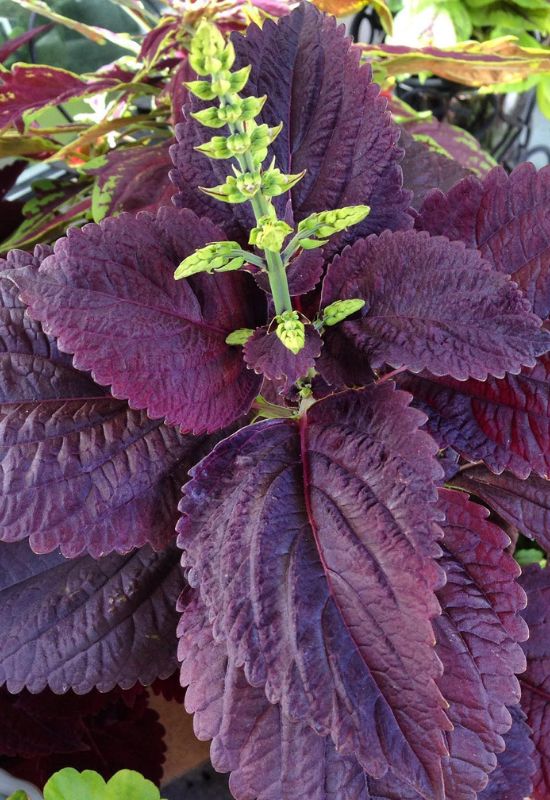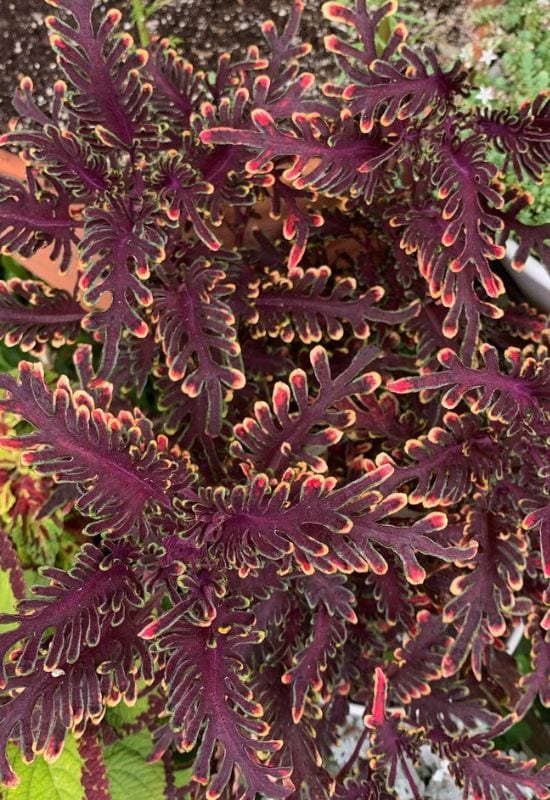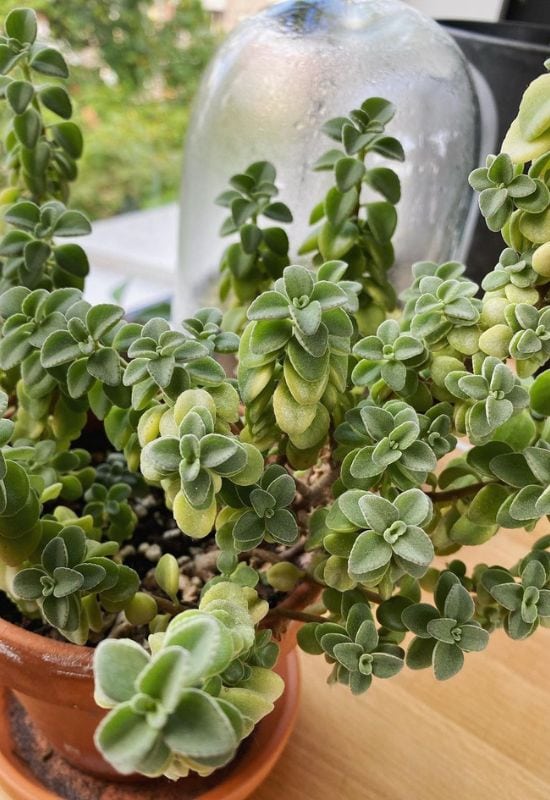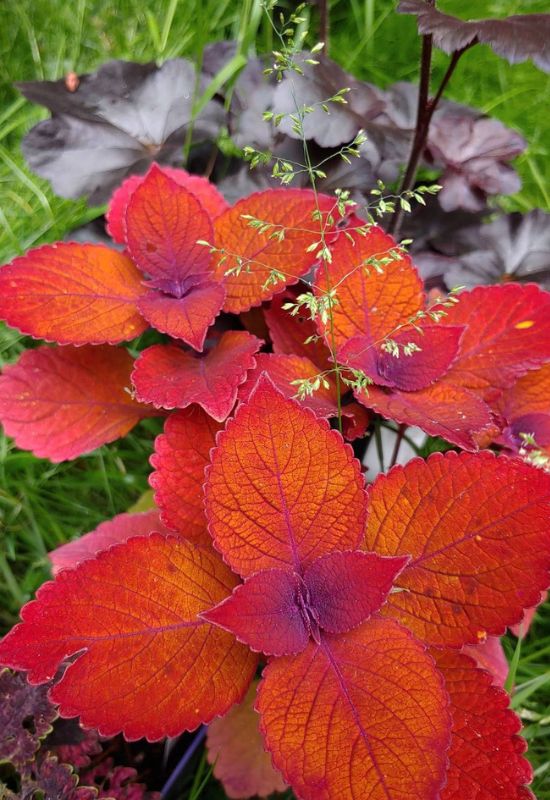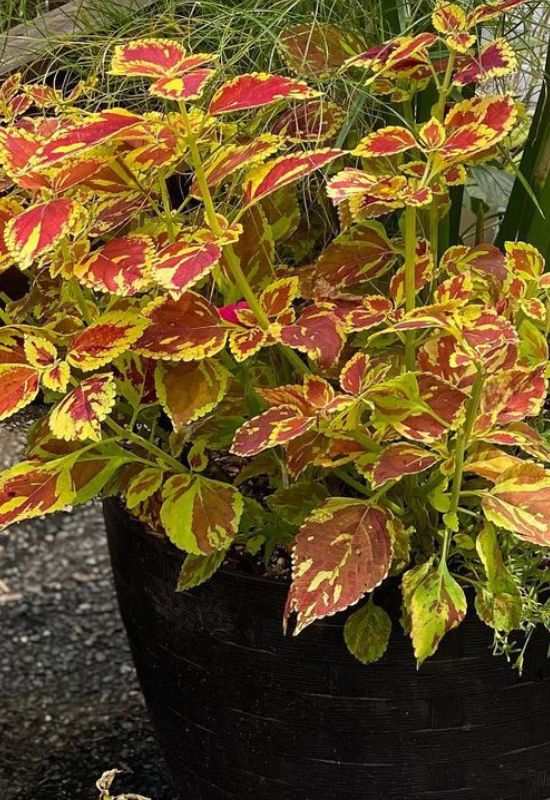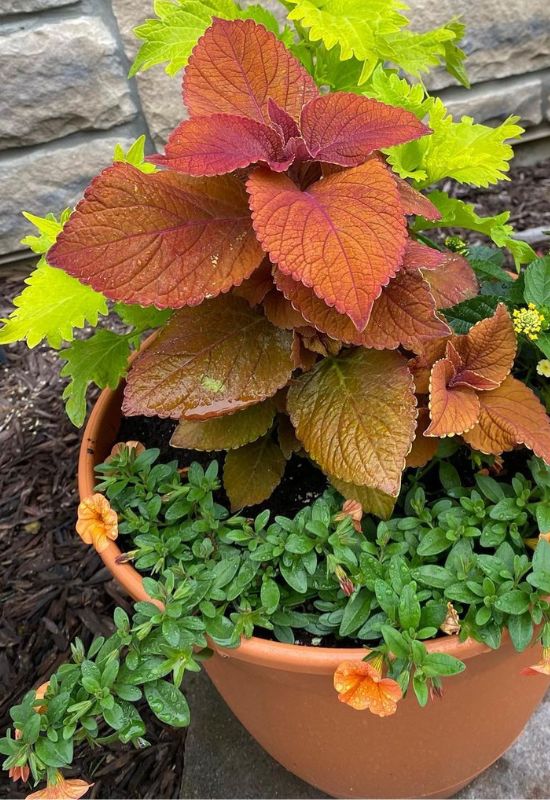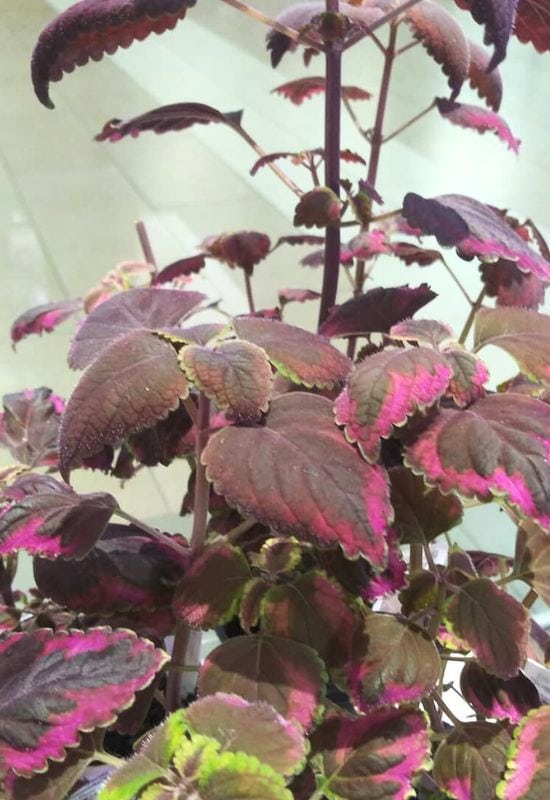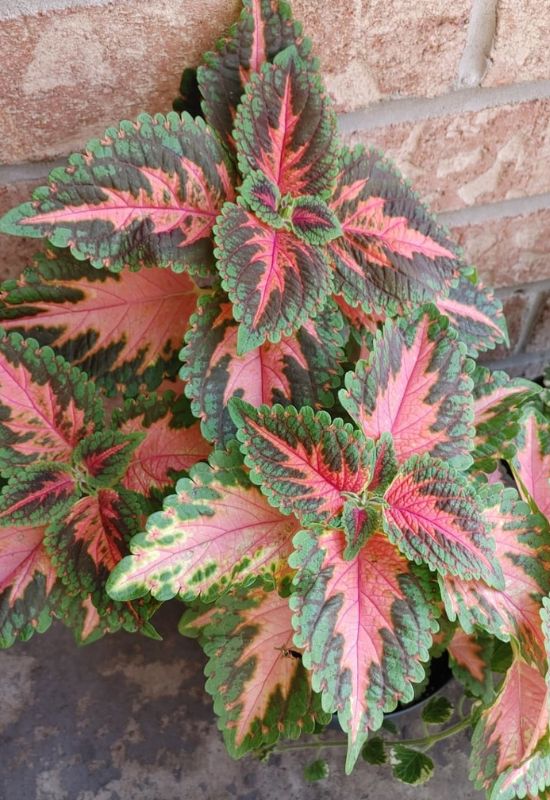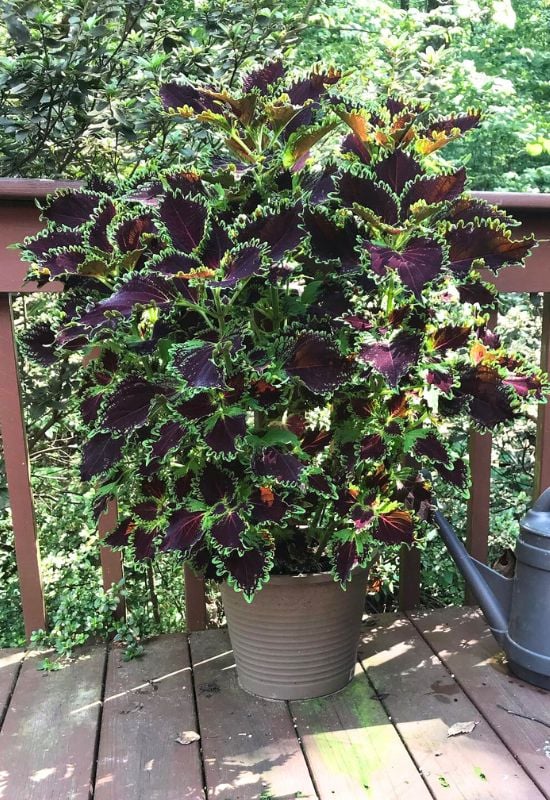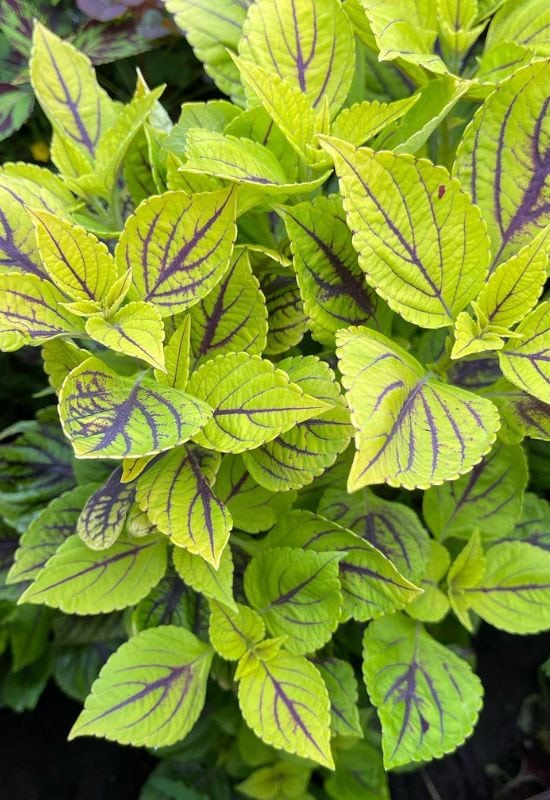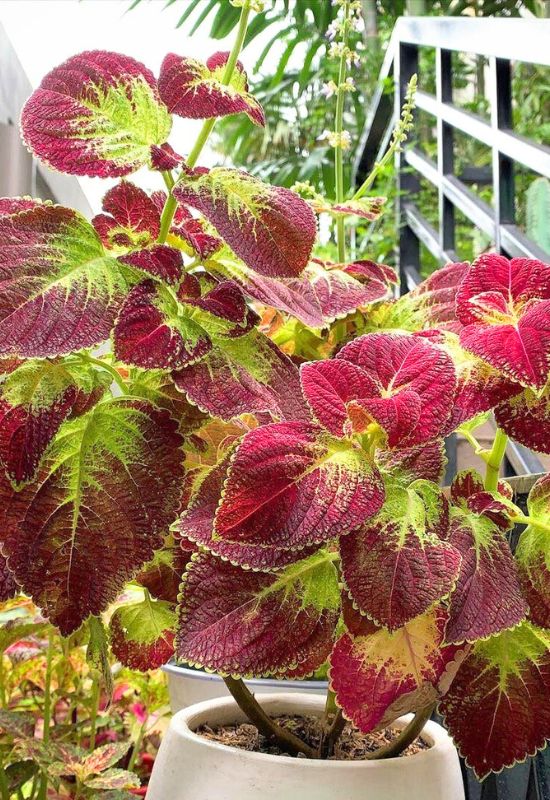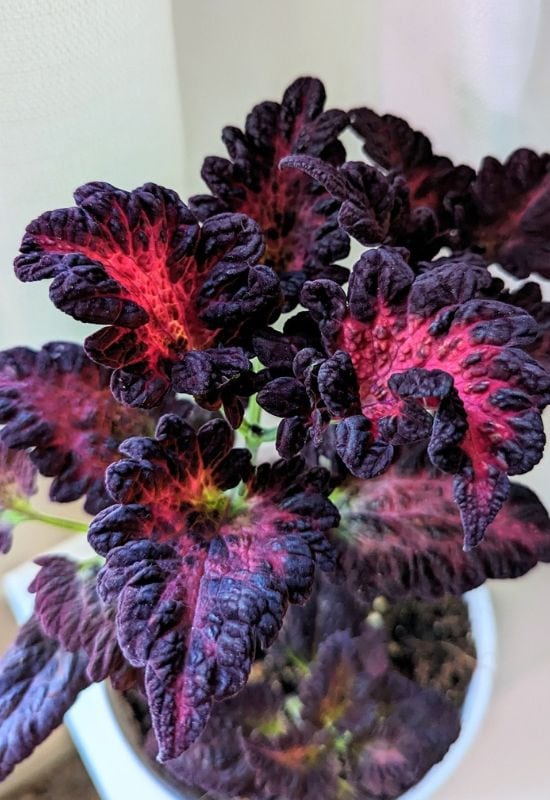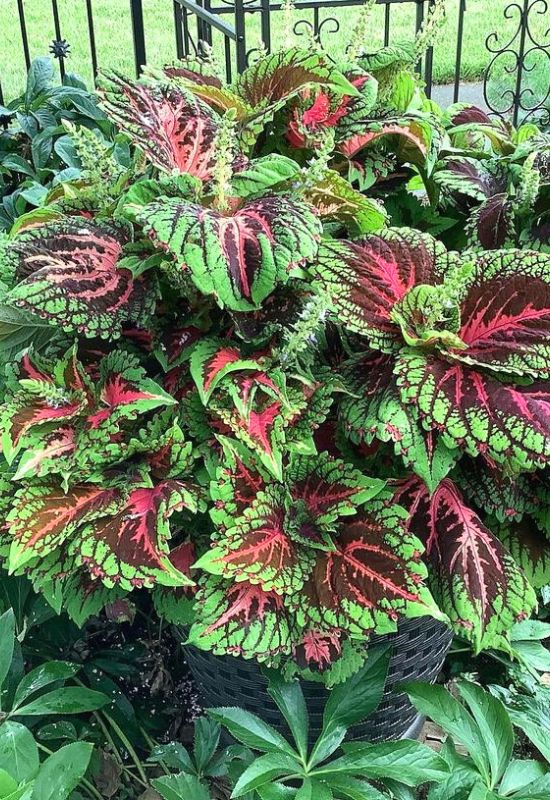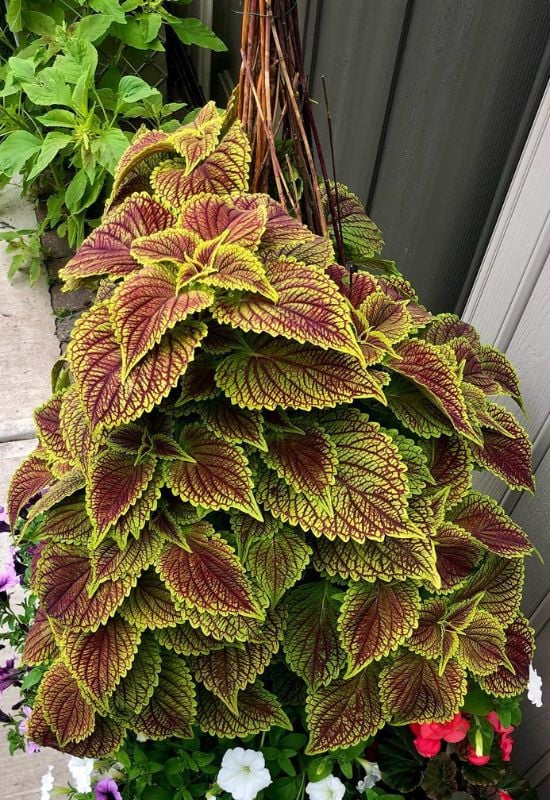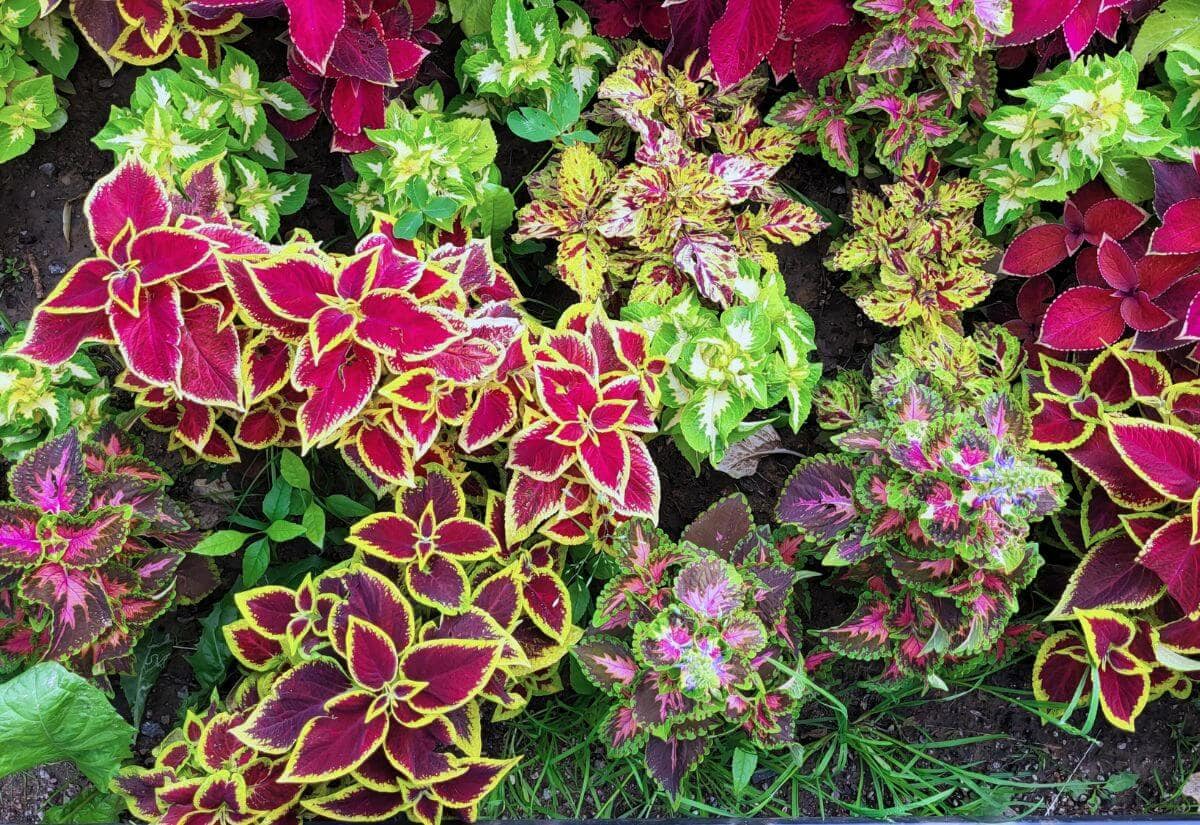
Maybe the title of annual king of Sun goes to sunflower, but we can at least agree that coleus deserves the rank of “prince of colors”?
Not big but packed with a palette to make the rainbow itself feel a sting of envy, this shrubby genus (actually a subtribe) from Africa, Asia, Australia and Java can bring you a leafy spectacle of greens, but also yellows, oranges, reds, violets, purples, in all combinations and with variegated pattern on its decorative, slightly velvety foliage that demands respect!
Very easy to grow, Coleus is a tender tropical plant that fears frost, rarely withstanding temperatures below 5°C, which is why it is grown as an annual, sowed or replanted every spring in gardens, planters, or pots. It also makes a wonderful indoor plant that can thrive year-round inside homes.
Interestingly, there are also perennial and even succulent varieties of coleus, and there has been some confusion with its classification.
However, on the market, most are Solenostemon. But we won’t focus on this. In gardening terms, it is simply hard to beat the carnival of kaleidoscopic tonalities that its dense clumps bring to your borders, flower beds or even containers.
And, while most coleus varieties will enjoy dappled and part shade as well, many will really thank you if you choose a full Sun position. And they will do it with the vibrant, sometimes striking, coloring of their leaves!
So, if you are looking for an easy to grow plant to keep spice up your garden with its colorful leaves, check out our selection of the most decorative and brightly “painted” coleus to add a dynamic and artistic flair to your flower bed borders, pots, and planters!
But first, a few words on it’s botany and another beauty of coleus, often underrated…
Coleus Are Flowering Plants, Not Just Leafy Beauties!
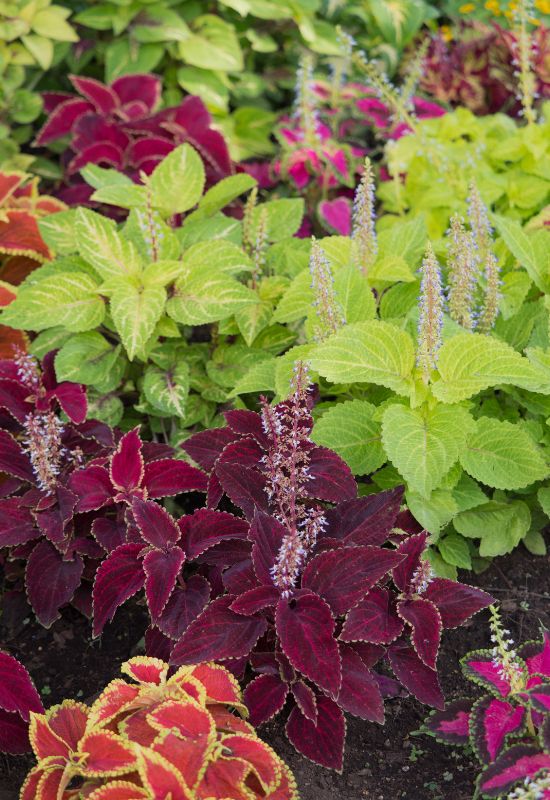
Coleus, originates from the tropical forests of Africa, America, and Southeast Asia and belongs to the Labiaceae family, alongside mint, sage, and lavender. While it’s a perennial in its native habitat, it’s often grown as an annual in gardens or as a houseplant in colder regions because it struggles in temperatures below 5°C. Formerly classified under the Coleus genus, it’s now recognized as Solenostemon, boasting over 150 diverse species, cultivars, and hybrids. This plant offers a stunning variety in shape and color!
The leaves can be brightly colored or subtly hued, solid, or patterned in two or three shades. Their hues can be unexpected, from vibrant to muted, showcasing a spectrum from wormwood green to bright yellow, rust to deep purplish-red, and even shades of pink or creamy white.
Coleus stands out for its vividly colored foliage. Its stems are quadrangular, fleshy, and fragile, giving rise to deciduous leaves that are opposite in arrangement, and can be oval, heart-shaped, slightly toothed, or deeply cut. Some leaves are so ribbed and wavy, they seem embossed. They’re hairy underneath and velvety on top, ranging from 2 to 15 cm in length. Their appearance is reminiscent of nettle or mint leaves. Depending on the species, the leaves might be triangular, lobed, fringed, or ruffled.
When we think about coleus, we immediately imagine colorful leaves. But they do blossom as well! Usually in mid summer summer, you will see long spikes bearing small, but large lipped and almost butterfly like flowers on them. These can be bluish to lavender, but there are varieties in white and pink as well.
Anyway, these are often underrated in my opinion. In fact, many gardeners even cut them off, to keep the leafy clump “neat”…The fact is that when they blossom, they will thin their foliage for that time…
Well, it’s up to you if you want to keep them, but my general advice would be to give them a go first. They may add another element to your flower bed, border or container.
And now, let’s set off on this colorful journey in the leafy world of coleus varieties!
25 Super Colorful Varieties of Coleus That Will Make Your Garden Pop
Before you read the coleus varieties we have picked for your sunny beds or borders, put your sunglasses on! Here they are!
And the very first coleus variety we have found for you will amaze you, but it is only a start!
1: ‘French Quarter’ Coleus (Solenostemonscutellarioides ‘French Quarter’)
You will be puzzled when you first see the leafy mound that ‘French Quarter’ coleus will produce under the warm rays of the Sun in your garden… In fact, we have picked it because it has a perfect mix of colors on its heart shaped and crenated leaves…
In a length of about 2 inches, or 5.0 cm, this tender perennial variety can pack in a central flame in the brightest magenta to crimson shade… To heighten the effect, this is surrounded by a dark, maroon, almost brown halo…
But it will then it suddenly changes to a luminous pear green note at the margins… A late bloomer, the flowers are lavender and paling to almost white in the center.
Usually grown as an annual, ‘French Quarter’ is one of the most dramatic varieties of coleus you can grow in your sunny garden, and it is perfect to lift up any dull border or bed, or even terrace or patio if you wish!
2: ‘Pineapple’ Coleus (Solenostemonscutellarioides ‘Pineapple’)
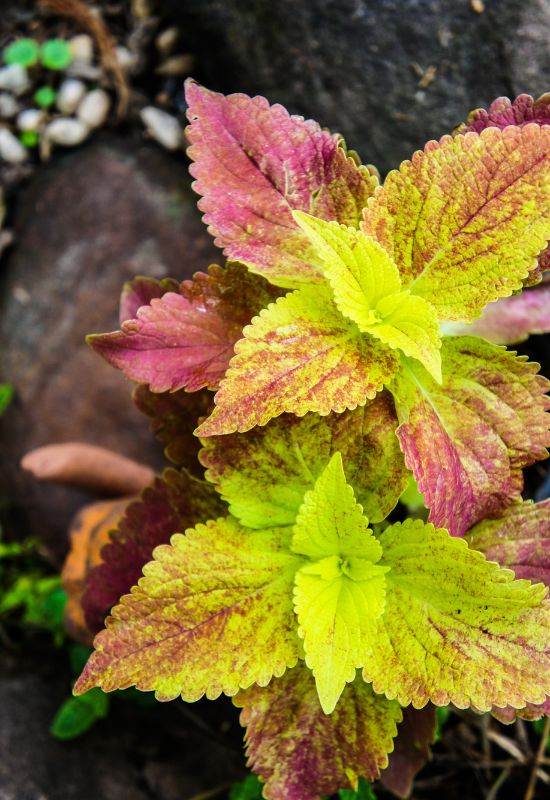
But maybe you are looking for a variety with a gentler, fresher and less dramatic personality for your sunny beds? Then have a look at ‘Pineapple’ coleus…
To start with, it still forms a very dense mound, but the leaves are more lance shaped, rather than cordate, with margins that are serrated (with teeth pointed forward), rather than crenated.
And it is just here, at the margins, that you will find a thin and elegant line of mulberry, maybe boysenberry purple. This can also repeat in patches at the center of the foliage, but most of it…
Well, the major tonality of this cultivar is a luminous and very sophisticated chartreuse to lime green! Very uplifting and positive, it does not grow much big, it will blossom in mid summer with lovely spikes of lavender flowers.
‘Pineapple’ is the coleus variety you want for a fresh and invigorating touch to your sunny garden, and it will give you a sense of spring all through the year (in warm countries) or till fall (if grown as an annual).
3: ‘Black Prince’ Coleus (Solenostemonscutellarioides ‘Black Prince’)
Talking of royalty… Sun loving ‘Black Prince’ is one of the most stunning and gothic varieties of coleus you will ever find! And it is also in the pantheon of garden plants, having won the Award of Garden Merit by the Royal Horticultural Society!
Heart shaped and broad, the softly serrated leaves of this dark beauty display an impressive tonality of purple, very convincingly on the deep indigo violet note.
This exalts the velvet like texture of the foliage, and if you look closely, you may see very faint hints at white at the very margins.
Medium sized and very sought after, it is a delicate bloomer… From early to mid summer, it will produce lavender and white blossom on tall spikes, an elegant contrast to its lustrous and leafy mound.
‘Black Prince’ is the variety of coleus you want as an accent plant, to bring a sense of luxury and style to your sunny garden – or terrace…
4: ‘Inky Fingers’ Coleus (Solenostemonscutellarioides ‘Inky Fingers’)
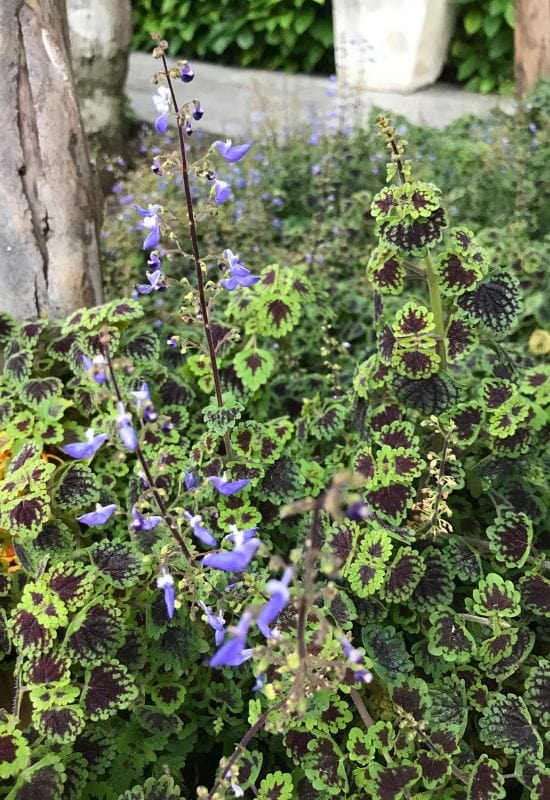
Maybe not the most classic variety of Solenostemon, ‘Inky Fingers’ is instead a very original one… And the name is a clue…. The shape of its leaves sets it off from its sisters, because they are broad and deeply lobed, forming rough fans, or triangles…
In fact, they may even look palmate to you… And this is because of the hand shape that’s painted by the purple patch in the middle, on tonalities that vary from raspberry to royal, depending on lighting.
But as you are planning to grow it in a sunny spot, you can expect best results… All around this fingered blotch, you have a “frame” that follows it in bright emerald to bluish green, again, depending on sunlight exposure. The flowers come in mid spring, and they have a gentle pale rose tonality.
Playful and child friendly, ‘Inky Fingers’ coleus provides lots of fun and contrasting colors to your green space, and it really gives you its best with plenty of sunlight.
5: ‘Kiwi Fern’ Coleus (Solenostemonscutellarioides ‘Kiwi Fern’)
And here’s another variety of coleus with an individual and even rebellious, but very sunny personality for you: ‘Kiwi Fern’!
The fact you will notice straight away is that it has longer leaves, up to 3 inches (7.5 cm) and that they have deep lobes on each side, appearing almost pinnate, or like some oak species.
This makes the, look like fronds, and that’s why it deserves its name. You will enjoy a variegation of two colors on the foliage, with a central plum purple area, which sometimes takes over.
The margins, however, can be green, bluish or sometimes even yellowish, and they can change tonality as the season progresses.
It also has an open habit, which allows you to enjoy its texture at best. Instead, the flowers are of a very delicate sky blue color, and they appear like a heavenly touch in a very intense composition.
By far one of the best coleus variety if you want original and almost sculptural foliage and texture, ‘Kiwi Fern’ will never disappoint your sunny garden, and I could see it well even in a rock garden, or interlacing other plants with its leaves.
6: Succulent Coleus (Plectranthus hadiensis var.tomentosus)
Here’s the odd one out for your sunny garden! Plectranthus hadiensis, is actually of a different genus, though once they were classed together and it has remained a coleus variety for gardeners!
And it is very unique, because it is semi-succulent, and its leaves are scalloped and fleshy, not colorful but of a pale parakeet green color, and with a thin, delicate and white down on them, like dew… And in fact, it is also known as “hairy coleus”.
What is more, they are aromatic, and they can also be used in cooking… And this relative is from South Africa, where it is also called Vicks plant, or Cuban oregano… So, a citizen of the world with many personalities, but also a good bloomer…
Long green or sometimes purple spikes of flowers in light blue with a dash of violet in them, or sometimes mauve or even white, will appear in early spring, and then again in fall!
Excellent in sunny spots, even in rock or vegetable gardens, succulent coleus will also tolerate dry conditions, which can come in handy, and what it makes up with aroma for what it lacks in color…
7: ‘Redhead’ Coleus (Solenostemonscutellarioides ‘Redhead’)
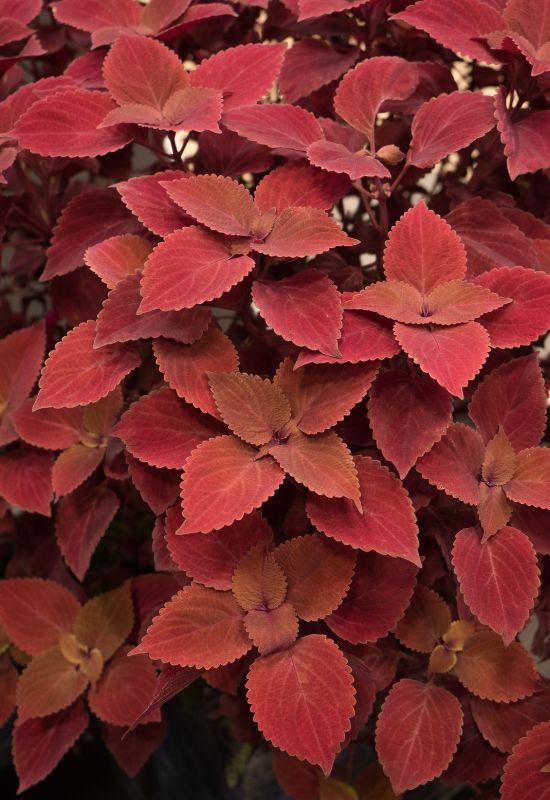
We come back to a more traditional looking variety with sun loving and very energetic ‘Redhead’! Of course, the most striking feature of this Solenostemon is the amazingly bright and vibrant color of its finely serrated and heart to lance shaped leaves…
In fact, they are perfectly crimson, though I have seen specimens turn into an intense ruby shade as the season progresses, especially if grown in full Sun. So, you too may enjoy this transformation…
The foliage also has a very soft, velvet like texture, which makes it very sumptuous and classy! Winner of the Award of Garden Merit by the Royal Horticultural Society, most gardeners cut the flower spikes when they emerge, because they want to to keep the lush clump at its best. However, I also find that the delicate lavender colored blooms are a nice and elegant contrast.
Surely the coleus variety you want for a splash of energy and elegance in your sunny garden, ‘Redhead’ is also a very popular one, which draws lots of attention, but is also very easy to find on the market. Being fairly big, it is ideal to bring lots of color in a large border.
8: ‘Henna’ Coleus (Solenostemonscutellarioides ‘Henna’)
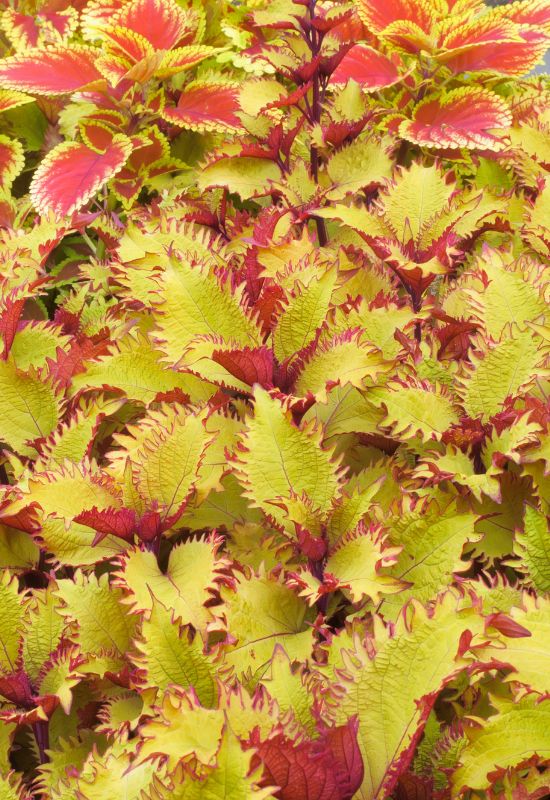
One of the most intriguing varieties of Solenostemonfor sunny gardensis ‘Henna’ coleus, in my opinion… In fact, it mixes an extremely sophisticated palette with really great texture…
Let me explain… the leaves are frilly at the margins, thanks to clear cut but irregular dents, which create a very decorative effect.
But to this, you need to add the rare and elegant shades that the foliage displays… It will give you a bright chartreuse core, which takes up most of the surface, but then, at the edges, copper to rust and sometimes even pinkish come as a dusting that heightens the contrast and highlights the puzzling shape of the leafy mound.
And you will get the most vibrant colors if you grow it in full Sun. The undersides are reddish, while blossoms are lavender blue, and they come in summer.
No wonder ‘Henna’ is yet another winner of the famous Award of Garden Merit by the Royal Horticultural Society, and a great pick for a bright, contrasting but also very refined beds, containers or borders in full Sun.
9: ‘Campfire’ Coleus (Solenostemonscutellarioides ‘Campfire’)
Honestly, I think a better name for this Sun loving variety of coleus would be ‘Blushing Girl’, but its real name is ‘Campfire’. Let me prove my case… The leaves have the most classic shape of Solenostemon, broad lance to slightly heart shaped, with a soft crenellation on the margins.
But the palette will offer you amazing shades of peach, rose, some copper and then they heat and, in fact blush up to a lovely magenta pink with the new leaflets in the center!
All these delicate but bright colors mix seamlessly like on a beautiful canvas, and the overall effect is romantic, rather than dramatic. The spikes of little flowers will offer you pale blue blossoms, if you wish to keep them for contrast.
I think I can rest my case, then. ‘Campfire’ is a small variety of coleus that you want for a blush of romance in a sunny garden, again, suitable for beds, containers and even a dreamy rock garden if you wish.
10: ‘Lime Time’ Coleus (Solenostemonscutellarioides ‘Lime Time’)
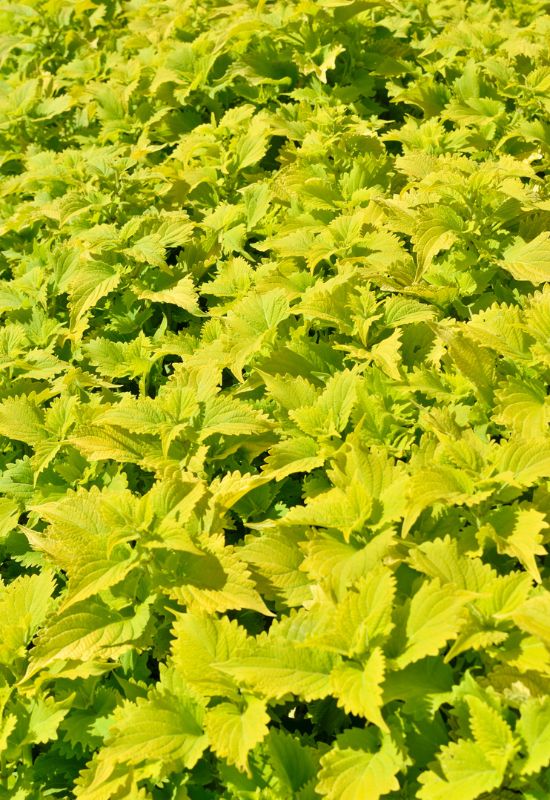
Moving on to a totally different variety of Solenostemon, ‘Lime Time’ is a “simpler” coleus than most we have seen. To start with it has no variegation on its leaves, apart from the odd whitish bleaching on the mid ribs and sometimes on the veins.
On the other hand, it offers you the most refreshing and bright lime to chartreuse color ever! This makes it great in the summer Sun, when it reflects lots of light, but at the same time it can cool down your garden with its citrus infused tonality…
It is also a fairly big variety, so, and its monochromatic foliage can give you large and continuous patches, even for formal spaces. As with other varieties, it has lavender blue flowers, but they add to the luminous presence of ‘Lime Time’, rather than offer a contrasting element.
For a sunny garden, it will prefer some afternoon shade in humid places, and you can have it in borders, beds, containers like others, but I have quite often seen it used for edging, maybe because its bright and fresh coloring is just perfect to define lines and shapes.
11: ‘Freckles’ Coleus (Solenostemon scutellarioides ‘Freckles’)
‘Freckles’ is one of my favorite coleus varieties, and I hope it will be one of yours too… Let me try to convince you. To start with, it has very broad foliage with a lovely round and regular crenellation on the margins. But what really strikes me is the colors!
The variegated leaves have mainly orange on them, in bright shades from canary, through carrot and even fire, touching on scarlet in the most intense spots. But then, here and there you get lovely patches of lime yellow, which give you a balanced but eye catching contrast.
And you will get the best out of this mosaic of light if you grow it in full Sun! Most people love this effect so much that, in order to keep it intact, they cut the spikes of whitish flowers that come in summer.
Reflect the light of the Sun in a patchwork of bright and warm, energetic but elegant colors with the foliage of ‘Freckles’ coleus in your beds, borders and containers, and it could be summer all year round in your garden.
12: ‘SedonaSunset’ Coleus (Solenostemon scutellarioides ‘SedonaSunset’)
A fairly large variety of Solenostemon, ‘Sedona Sunset’ shows off all the ability of coleus to achieve chromatic perfection even in very difficult shades. While it may look like the foliage is monochrome, this is not fully true though.
Yes, the amazing, strong, decided and really impressive tonality of copper orange it displays is really jaw dropping! And its broad leaves with very short denting shows it off to idyllic heights!
But look closely and you will see that it blushes to darker tones towards the edges, with a hint at ruby… And this is fully expressed in the hew leaflets in the center, a “trick” to draw your eyes in… Yet again, you will get the best color results with plenty of light.
It is a fairly large variety, so it can literally offer you big and even overwhelming effect… Pale blue blossoms will appear in summer, usually removed by gardeners.
One of the most powerful varieties of coleus, ‘Sedona Sunset’ is great to spark up whole borders with its unique foliage color, but in beds and containers it is no less valuable.
13: ‘Trailing Plum’ Coleus (Solenostemon scutellarioides ‘Trailing Plum’)
So far, we have seen varieties that form clumps, often taller than in spread, but how about one with a totally different habit for your sunny green haven or terrace?
Enter ‘Trailing Plum’ coleus, and the name says it all… Or almost all… Yes, unlike other Solenostemon we have seen so far, it produces long stems that, of course, trail, and the foliage is arranged on them more or less densely…
Form a distance, you will certainly agree that it is in the color range of the fruit it is named after… However, look closely and you will notice that it’s not as simple as that.
To start with, the leaves are fairly irregular in shape, and they offer you a variegation in the pink to purple gamut, with cerise, magenta, crimson, plum and even burgundy.
And then, the margins are cream! The white flowers come in summer on the typical long spikes, and I would suggest keeping them in this case.
Like with other varieties, the exact colors of the foliage of ‘Trailing Plum’ will depend on light exposure, and this coleus can grow even in full shade. Having said this, it is by far one of the best picks for rock gardens and containers, even hanging baskets.
14: ‘Wizard Coral Sunrise’ Coleus (Solenostemon scutellarioides ‘Wizard Coral Sunrise’)
We now come to yet another master of colors in the Solenostemon genus… In fact, you will agree that ‘Wizard Color Coleus’ has a palette that takes your breath away… This variety in particular will change its shades according to light exposure, and with full Sun giving you the brightest results.
What should you expect then? A central plume on the pink range, is what gives it its name… This can go from salmon to coral and even rose in some specimen… This then forms veins that fade into a series of greens, including moss, forest, fern and even shamrock.
In some cases, the area in between darkens to brown purple… Of course, you will need broad leaves to achieve all this, and in fact it does have them, and with soft crenellation as well. This is one of the cultivars where the spikes of lavender flowers are usually cut, for obvious reasons.
Arguably one of the most colorful Sun loving varieties of coleus, and a favorite houseplant too. Its amazing tonalities make it great for flower beds or containers…
15: Henna Coleus (Solenostemon scutellarioides ‘Balcenna’)
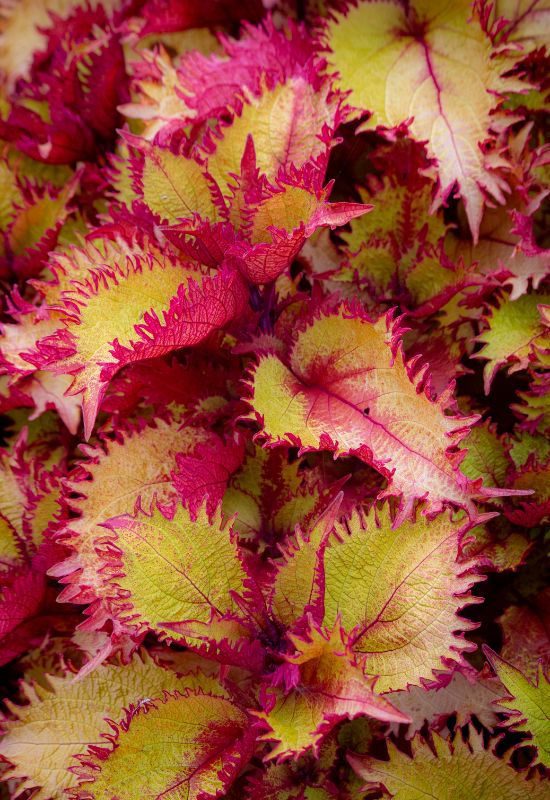
Henna, or ‘Balcenna’ coleus offers you a very intriguing mix of unruly energy and classy sophistication. This amazing effect is achieved thanks to the shape of the leaves, which are deeply dented, and this gives them a very frilly personality.
So, the foliage has a fine but almost wild texture, and this is then heightened by its coloring… In fact, look at the margins and you will see a russet shade, with burgundy in it.
While this continues to take over the undersides, on the upper page, most of the surface is of a brisk chartreuse tonality, giving you great contrast between citrus freshness and a warm depth.
The actual balance can change through the season, and you may expect blushes of rose and magenta as well. This variety is also a winner of the Award of Garden Merit by the Royal Horticultural Society, which is not surprising at all! It too will blossom, adding a touch of suave sky blue to the ensemble.
Perfect for rock gardens or containers, henna coleus is one of the best variety for texture and color, and an original touch to any garden. Being fairly big, it will also suit borders, filling them with its grace!
16: ‘Wicked Witch’ Coleus (Solenostemon scutellarioides ‘Color Blaze Wicked Witch’)
As its name suggests, ‘Wicked Witch’ is a coleus variety with a very deep, unfathomable personality… Well, in fact it has a very interesting trait, to start with.
The breeders of this cultivar have brought out an unusual shape in the margins of the foliage: it is cut, dented, but it actually forms little round lobes, many of them, like… children’s toes, one would say…
These sweet but fine and mellow edges give texture, and even more so because a thin but clearly defined chartreuse lone follows them all along, sometimes tending more towards the green, sometimes yellow.
All this beautifully frames the very dark, intense, even luxurious burgundy color of the rest of the leaves, where you will see the veins taking on rose magenta brightness at times, if you look closely.
Quite large among Solenostemon varieties, it will blossom as well, but late in the season, which is a sought after quality by gardeners who want to preserve its colorful leafy beauty as long as possible.
Given its size, ‘Wicked Witch’ can add depth to sunny borders as well, on top of being great for containers, and lots of light will bring out its deep coloring, for an intense leafy effect.
17: ‘Chocolate Drop’ Coleus (Solenostemon scutellarioides ‘Color Blaze Chocolate Drop’)
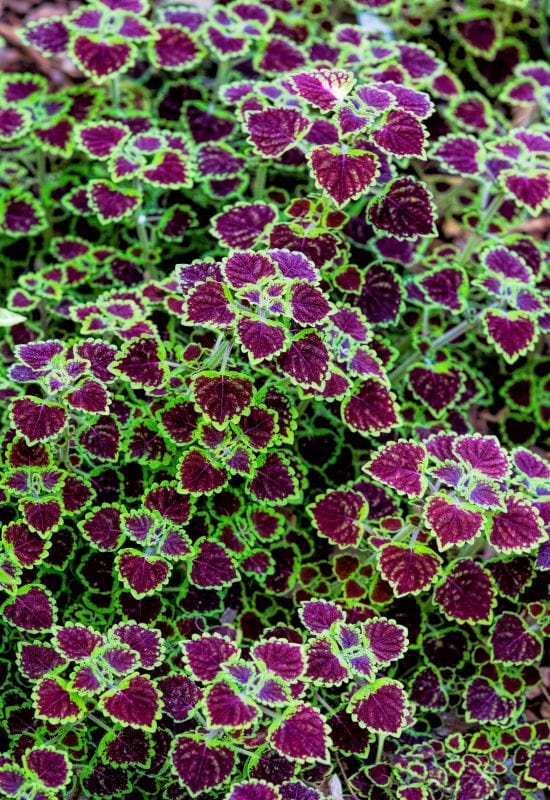
Here’s another amazing cultivar of coleus from the ‘Color Blaze’ series, called ‘Chocolate Drop’; and perfect to perk up and brighten up sunny gardens. Yes, because it has one of the most striking contrasts you can achieve…
Its foliage has two colors, one is green, which forms the background, but in a lovely aquamarine tonality, though, depending on light, this can take on hay or fern shades as well…
In the middle you will see a lovely, bubbly pattern of very deep burgundy purple, which follows the veins and forms decorative shapes that may remind you of a peacock’s tail, or a dark frond painted on the surface…
What is more, the leaves are roughly triangular, with a flat base where they are attached to the petiole, and then curved edges. And the margins have a regular crest of soft and round lobes, which really add to the beauty of this variety. The blooms, as usual, come late, and it is up to you if you wish to keep the pale blue flowers.
If you like striking patterns, then ‘Chocolate Drop’ is the coleus variety you will really enjoy in a sunny or part shade border, or in containers, and why not, even mixed in with flowering plants in beds.
18: ‘Gray’s Delight’ Coleus (Solenostemon scutellarioides ‘Gray’s Delight’)
And for a refreshing and rejuvenating variety, the cultivar ‘Gray’s Delight’ is just perfect to soften the heat of sunny days, in full Sun or part shade, as you wish… Why?
Put simply it has the most enchanting, crisp lime green ever! It almost “looks fragrant” and it is really luminous and uplifting… Sometimes more on the yellow side, sometimes more on the greenish, this may depend on lighting conditions, but it is always very, very valuable in a garden.
And… yes, it also adds yet another interesting trait to its leafy display… You will see that the mid rib and the veins stand out from this uniform backdrop, with a deep purple color which draws abstract patterns on these natural canvases!
The leaves are broad and lance shaped, starting close to the stem, but they also have lovely crenated margins, with little lobes that are consistently round and regular in shape.
This is one of those Solenostemon varieties where cutting the blooms may be a pity, in the end… Yes, because their soft pale blue flowers do look good with the palette of the foliage… Up to you!
Excellent to freshen up and lighten up borders and flower beds, ‘Grey’s Delight’ coleus is also a winner of the famous Award of Garden Merit by the Royal Horticultural Society, so you will also grow a champion in your garden if you choose it.
19: ‘Dipt in Wine’ Coleus (Solenostemon scutellarioides ‘Dipt in Wine’)
Ok, I guess you worked out the Dionysian personality of this cheeky variety of coleus, called ‘Dipt in Wine’… Its playful name also matches its appearance, in many ways… But let’s see why…
At the edges, you will find a very thin line of lime green, which follows the little round crenation very closely, only sketching it in many ways. But this does have a role in giving texture to beds and borders, and you will also find a little dusting of the same color at the center of the leaves.
Lance shaped and broad, and often with a gentle fold in the middle, these have a little “vice” though… They have a wine red to purple blush, which is the prominent shade of this leafy beauty, and this will become more and more intense with sunlight and as the foliage matures, and as the season progresses into the hot and sunny days of summer…
It looks like it’s getting more and more drunk all the time as you water it to quench its thirst! The soft blue flowers can offer some delicate contrast and light, but, as usual, this will be to the detriment of its dense foliage.
Great for a lovely blush of sparkling colors in sunny or part shade beds and borders, ‘Dipt in Wine’ is on the large side, as coleus varieties go… For this reason, it will offer a visible splash of color that can really become a dramatic presence in any informal garden, even in containers.
20: ‘Rustic Orange’ Coleus (Solenostemon scutellarioides ‘Rustic Orange’)
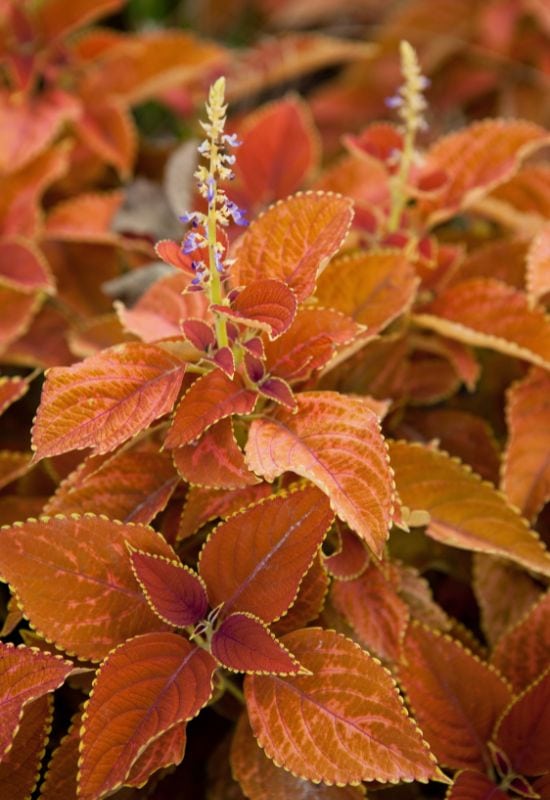
We must admit that coleus is the most colorful leafy plant you can grow as an annual or evergreen perennial in your garden, and ‘Rustic Orange’ is the living proof of this… In fact, it hits wonderful notes of orange (of course!) that are really hard to get in foliage, even when it is changing before falling to the ground in fall.
But the tonalities it displays have no sense of melancholy or decadence. You will see a glow of dark, Spanish and fulvous shades that edge to rusty, and the very fine texture of the surface gives these incredible leaves the appearance of sand…
With lots of light, older leaves can warm up to almost red, while the new ones at the top can blush to rosy tones, with a hint of magenta, which can add a visual focal point in the middle of the round mounds it forms.
They are clearly lance shaped, very well formed, and with a wonderfully fine crenellation at the margins. The flowers will come in late summer, but, as usual, most gardeners would cut them.
It is hard to match the intense and warm, sunset feel that you get with ‘Rustic Orange’ coleus; it can really transform even neglected borders of beds into works of natural art. Its coloring is simply outstanding!
21: ‘Black Dragon’ Coleus (Solenostemon scutellarioides ‘Black Dragon’)
Here is another cultivar of Solenostemonwith a really, really gothic, shady oersonality: ‘Black Dragon’! The name says it all, or almost… Well, it is not really “black” to start with…
As you know plants of this color really don’t exist, because they need to absorb some light for photosynthesis… But this variety reaches a depth of dark purple that is a real feat!
It can be a bit more on the violet side, or sometimes on the burgundy range, but it is always very intense. Sometimes, raspberry notes develop in the center of the leaves, which have large lobes, and they form a very decorative and dense clumps.
What is more the surface of the foliage is uncharacteristically smooth… You will see bumps on it, but the texture gives this short lived perennial an unusually semi glossy quality, especially in full Sun positions. Here the flowers will provide a touch of heavenly light, which may be a twist at the end of the season.
For drama and a sense of depth, ‘Black Dragon’ is a really stunning coleus variety to grow in sunny beds; like other plants with leaves in the color of night, they always have a particularly intense and even sculptural quality. It is also a small version of Solenostemon, so, it is ideal for little pots, containers and rock gardens.
22: ‘Limelight’ Coleus (Solenostemon scutellarioides ‘Limelight’)
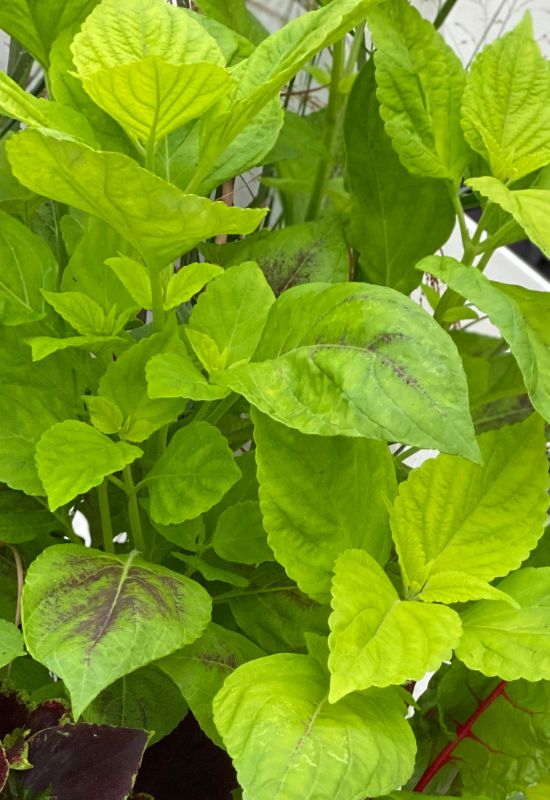
Ok, we all love coleus for its carnivalesque palette of all colors, but why not a green variety? Enter ‘Limelight’, a lovely and fresh looking variety of coleus that plays with a range of colors that start with bright emerald, and then they progress…
As usual, the actual shades it develops will depend on lighting, and a full Sun position gives it the best chances to bring out its full potential… So, you will see it take on lime tonalities that can then turn to a greenish yellow note, very close to chartreuse…
In any case, it is one of the most luminous Solenostemonyou can ever have in your garden, and its broad leaves, lance shaped, have a lovely and regular crenellation on the margins, while the texture of the surface is very fine, like sandpaper, which adds to the gentle, soft and refreshing effect of this little beauty!
You can almost “smell” its citrusy colors! The bluish flowers that appear before fall can be an adjunct to its display, but you will really lose the sheer freshness of its leafy mound.
A small variety of Solenostemon, ‘Limelight’ coleus is perfect to bring a minty freshness to beds or containers in sunny or part shade gardens, as it keeps its brisk and breezy luminosity all through the hot season, and beyond, if you cut the blooms.
23: ‘Kong Salmon Pink’ Coleus (Solenostemon scutellarioides ‘Kong Salmon Pink’)
‘Kong Salmon’ pink is a bit of a weird coleus cultivar. In fact, if you think that all you get with this Solenostemonis salmon pink, think again! To be honest, this is one of those varieties that change a lot according to sunlight and the seasons, maybe one of those that does it best!
Yes, true, in the center of the very broad leaves you will find the color of the famous fish, following the mid rib and the veins that depart from it, but this could also turn to coral orange or even rose and magenta, even to deep and vibrant levels.
All around it, you will see a darker plume on the maroon to brown side, which then fades, with little bubbles to reveal a green outer part. This too can vary in exact shade, from pale and almost hay to dark and almost forest…
Look at the margin and you will see a lovely and decided crenellation, which is not yet lobes. The bluish flowers will appear later in summer, but they will affect the overall effect of this leafy harlequin, making it fade and become spindly.
A very playful variety of coleus, ‘Kong Salmon Pink’ will be a favorite with children, and it is perfect to bring a lot of colors to beds, border fronts and containers, or rock gardens, which will express themselves at their best in sunny positions.
24: ‘Golden Dreams’ Coleus (Solenostemon scutellarioides ‘Golden Dreams’)
The evocative name of ‘Golden Dreams’ coleus is quite suited to the personality of this tender perennial… A fairly large variety, it will offer you a contrast that seems to shine with a light of its own; and this is – of course – thanks to the coloring of the dense leafy mounds it produces…
In fact, you will see a pattern of very decorative lines of purple, between the plum and burgundy tones, which follows the mid rib and the veins that depart from it.
These also give depth to the effect, while in between and especially towards the edges, you will find a lovely chartreuse shade, very luminous indeed, which seems to spring out from these natural canvases.
This tonality will be predominant in the newly born leaflets at the tips, which give this cultivar a luminous focal point.
Broad and lance to almost heart shaped, the foliage also boasts a lovely and elegant crenellation al, around the margins. This is one of those varieties where keeping the flowers would spoil the show…
Ideal to bring elegant light to sunny or part shade gardens, ‘Golden Dreams’ is excellent for beds, containers and also borders, especially if group planted, thanks to its luminous and – at the same time – dramatic foliage.
25: ‘Trusty Rusty’ Coleus (Solenostemon scutellarioides ‘Trusty Rusty’)
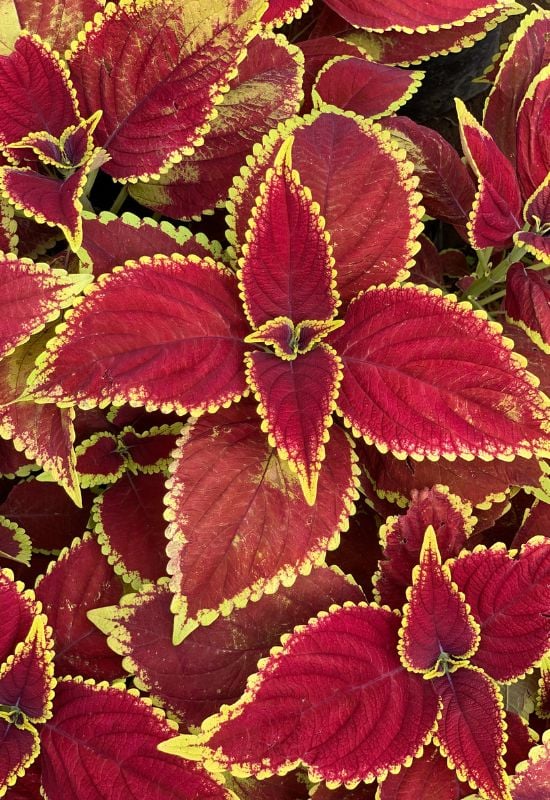
The final variety on our list will not disappoint you, especially in a full Sun position… Called ‘Trusty Rusty’ this is one of the most popular coleus cultivars in the world, and a champion as well, having won the Award of Garden Merit by the Royal Horticultural Society!
As you may have guessed, its foliage displays a particularly intense and deep tonality of rust red, which to be truthful, can pale to orangish in part shade, and in some cases even pinkish…
But you won’t have to worry about this with plenty of light; so, you can rely in it to deliver. What is more, the margins are serrated, regularly so, and with a range of color expressions that go from cram to green or even bright orange… forming lovely round clumps, the pale lavender blossoms are usually removed to keep it dense and vibrant.
‘Trusty Rusty’ adds depth and color to your sunny garden with its exquisite and strong palette, grow it in well lit beds, borders, rock gardens or containers, or use it for edging, where it can really recall an old fashioned frame…
Coleus Varieties: An Explosion of Colors
As we said, there are few plants that can really match the palette of colors that you get with coleus…
There are many more, in fact, but you have seen some of the most impressive of all, and now, you can take off your sunglasses and choose the ones you love best!

Written By
Adriano Bulla
After many years as an academic in London, Adriano Bulla became a writer, publishing books like A History of Gardening, Organic Gardening and Elements of Garden Design; he then decided to become a gardener, following his childhood dream, and has been following his dream writing and gardening professionally in Southern Europe, where he has specialized in new and innovative organic gardening fields and techniques, like permaculture, regenerative agriculture, food forests and hydroponics.

